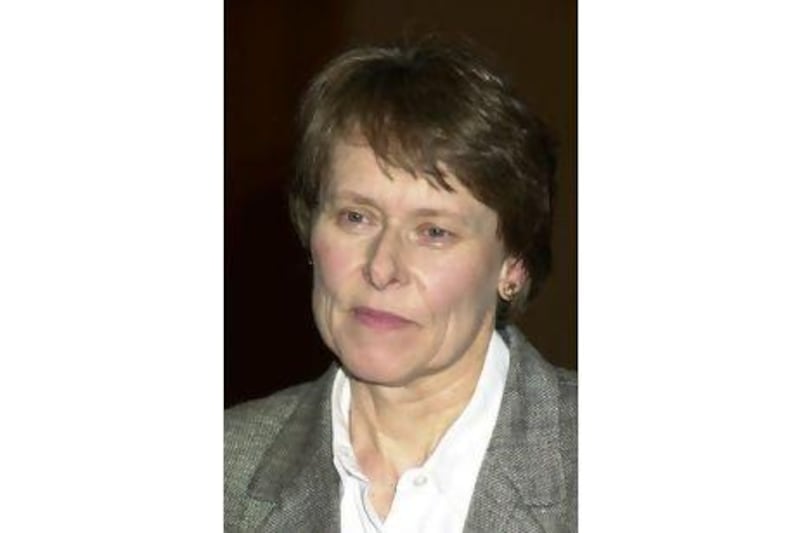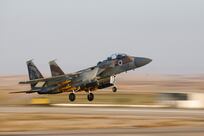Having walked where most women, and men, could only dream of walking, Namira Salim is busy preparing for the flight of her life. At 36, the Columbia University graduate has already conquered the North and South poles, skydived from Mount Everest and now plans to see the stars.
"I made a resolution to touch the heights of the skies and the depths of the ocean," she says.
The Pakistani-born, Dubai- and Monaco-based artist and self-confessed adventurer is preparing to make history again this year when she climbs aboard Richard Branson's Virgin Galactic flight into space.
When Salim first set out to explore the most exotic and perhaps treacherous corners of the globe, she'd forgotten the pact she'd made with her cousins as a child that would see her expand her horizons beyond the Earth's atmosphere.
"I always told my cousins and friends I would grow up to become an astronaut in times when private space travel was unheard of in the Eighties. Then when my news of the space trip with Richard broke, my cousins called me to remind me of what I'd said."
The amateur astronaut has been working alongside Branson in the lead-up to the flight and says the business mogul is "very warm, friendly and extremely patient with people". Salim, intent on being the first female space traveller from the UAE and the first Pakistani in space, has been busy preparing for her space debut since October 2007.
"The first part of my training took place in the world's most high-performance centrifuge, the STS-400 at the Nastar Center in the US," she says. The two-day training exercise was a simulated flight designed to test Salim's ability to adapt to motion sickness and gravitational forces.
"It was a complete simulation of the spaceflight from take-off, to rocket motor ignition, to blasting into space, to floating in zero G, to re-entry into the Earth's atmosphere, and landing in Spaceport America's Virgin Galactic Gateway to Space," Salim says. "I had a slight nauseous feeling upon touchdown but it disappeared in a few minutes. It was lots of fun and the best thing was clearing the medical tests and successfully completely the training programme."
In July 2008, MothershipEve, the high-altitude launch platform that will lift the rocket SpaceShipTwo to 50,000 feet before blasting it off into space was unveiled. The launch pad is named after Branson's mother, Evette, and because it's located at such a height - compared to a normal rocket that takes off from the ground - take-off will be much easier on the body, Salim says. Test flights are continuing throughout 2012, after which on a yet-to-be-confirmed date the adventure seeker will jet into space on the first private space-line in the world.
"It's a suborbital flight, which means we'll break the Earth's orbit at an altitude of 100 miles, float in zero G for a few minutes and then return to Earth," Salim says. "The entire experience, which will be in Virgin Galactic's super comfy cabins, will offer a 360-degree view from the ceiling, floor and wall windows into the stars, a thousand miles in every direction, and will last a few hours. We'll get to unbuckle our fully reclinable seats, float around the cabin, take pictures, write poetry or sing a song." Salim then jokes that in 1961 the first American in space, Alan Shepard, "made the same flight from Earth to orbit and back in a mere 16 minutes. But that must have been a bumpy ride".
Now more than 50 years later, Virgin Atlantic - which is 32 per cent owned by Abu Dhabi-based Aabar Investments- "the first private and commercial space-line in the world, is leading a revolution in space technology," says Salim. "It will be the safest and most commercially viable operation into space, and in the future will allow scientists, researchers and payloads to be delivered in space in a much more cost-effective and environmentally friendly manner."
Salim is the first to admit her adventures have been far from easy. During her Everest skydive, the first from the peak in October 2008, Salim not only was the first Asian to make the leap but also had to face weather patterns that were underestimated, which led to lives being risked.
"It was a late monsoon, the clouds came in very quickly and one of the jumpers had a serious crash," she recalls. While Salim came away unscathed she had to make the decision to keep the secret from her family.
"Then there was a plane crash which I hid from my family," she adds, "but soon it became world news, since all 17 Swiss tourists in it died. Despite that, and pressure from home not to jump, I did not give up. We sat waiting at the world's highest drop zone at 12,350 feet [3,764m] in Syangboche for weeks. It was an emotionally challenging time, but worth the wait. My lift was the last one, but the most beautiful, with not a single cloud. There were the most amazing view of the Himalayas from above Everest at 29,500 feet [8,991m]."
However, Salim insists that the view from Patriot Hills at the South Pole Ice Camp was even more sublime. She tackled Antarctica in January 2008, just months after reaching the North Pole in 2007, and was named the first Pakistani and the first woman from the UAE to have done so. "It turned out to be the most spectacular landscape of snow and ice mountains. It was literally like landing on another planet."
For a woman on these expeditions, the challenge is more than surviving sub-freezing temperatures, trekking for days and then hauling herself off the highest mountain in the world - it's proving that women can conquer anything.
"The biggest challenge was to convince my family to accept my risky pursuits," Salim says. "In this culture, such endeavours are totally unheard of, especially for women."
Now that Salim has reached the two poles, Everest and soon, space, she wants more time for her other hobbies - art and singing.
"I haven't been able to give much time to my passion for the decorative arts, music and poetry, particularly a traditional form of singing from Asia and the Middle East called ghazals," she says. "It's poetry about love, beauty and life, which is sung in a semi-classical style."
Salim can't confirm how she'll spend her few hours in space, but ghazals could be included. The dedicated artist also has her own line of decorative arts and collectables, A Soul Affair, which is available in Monaco, her second home.
The honorary consul of Pakistan to Monaco, Salim lives in the coastal principality when she's working on her decorative pieces, which include tea sets, lamps and interior design accessories. She sources materials from neighbouring countries including porcelain from Germany, glass from Venice, crystals from Austria and fabrics from Italy.
"The art was first introduced in Dubai through a high-profile exhibit in September 2000 under the patronage of HH Sheikh Ahmed bin Saeed Al Maktoum," Salim says. Then in 2001 Salim created another line of art, pieces that "have built-in music and humanitarian messages from the actual voices of world leaders including Nelson Mandela, Mother Teresa and Quaid-e-Azam, the founder of Pakistan". Salim's work has been exhibited at UN and Unesco summits to promote global humanitarian issues.
Out of this world
Private spaceflight will be available from December 2012 for tourists, and bookings are now being taken. Launching from Spaceport America in New Mexico, a two-mile-long spaceway, the flights will cost US$200,000 (Dh735,000). For more information, visit www.virgingalactic.com.
The Salim file
BORN Karachi, July 15, 1975
SCHOOLING Attended Pakistani schools through to high school; master's of international affairs from Columbia University, New York
FAMILY Parents Salim, a businessman, and Nahid, a housewife
FIRST JOB President of International Association of Students in Economics and Business Management in Pakistan in 1992
FAVOURITE QUOTE "Faith has to do with things that are not seen, and hope with things that are not in hand." - Saint Thomas Aquinas
PERSON TO BE STRANDED WITH ON A DESERT ISLAND No one. In solitude to to reflect, create and be inspired
LAST BOOK READ Letters to a Young Poet by Rainer Maria Rilke
CAN'T STAND Hypocrisy
CRAZIEST THING EVER DONE Skydiving Mount Everest
10 female space firsts
VALENTINA TERESHKOVA (1937-) An amateur parachutist, Tereshkova beat more than 400 applicants to be the first woman in space. During her three-day mission for the Soviet Union in June 1963, she performed tests on herself, collecting data on the effects of space travel on the female body.
SVETLANA SAVITSKAYA (1948-) Along with being the second woman in space, Savitskaya was also the first woman to walk in space. The former Soviet aviator flew aboard Soyuz T-7 in 1982 and two years later performed a spacewalk for three hours and 35 minutes. Through 2010, she is the only female out of 57 Russian and/or Soviet spacewalkers.
SALLY RIDE (1951-) The physicist was the first American woman to orbit Earth and the then-youngest American in space when she flew aboard the space shuttle Challenger in 1983 at the age of 32. She also was the first woman to use the robot arm in space. In 1986, Ride was named to the commission selected to investigate the 1986 explosion of Challenger.
HELEN SHARMAN (1963-) A chemist, Sharman was the first Briton in space, having visited Mir in 1991 during Project Juno, a joint operation between the Soviet Union and a group of British companies. She responded to a radio advert for applicants to become the first British astronaut and was chosen from among 13,000 male and female entrants.
ROBERTA BONDAR (1945-) Canada's first female astronaut was also the first neurologist in space. She flew on the space shuttle Discovery in 1992 and performed experiments in Spacelab. Bondar later led research examining data to determine how the human body recovers from exposure to space.
CHIAKI MUKAI (1952-) The cardiovascular surgeon was the first Japanese citizen to fly aboard the space shuttle, in 1994 and 1998. Experiments she carried out while in space included investigations on spaceflight and the ageing process as well as medical experiments on the cardiovascular and nervous systems.
CLAUDIE HAIGNERÉ (1957-) Haigneré, a French doctor and politician, and her husband are both astronauts and even have an asteroid named in their honour. Haignere spent 16 days aboard Mir in 1996 and was the first European woman to visit the International Space Station, in 2001.
KALPANA CHAWLA (1961-2003) The Indian-American scientist was the first Indian-born woman to fly in space, and travelled more than 10.4 million miles during her first mission, in 1997. Chawla was killed along with her six fellow crew members aboard the space shuttle Columbia as it burnt up when re-entering the Earth's atmosphere over Texas in 2003.
ANOUSHEH ANSARI (1966-) Ansari, an Iranian-born businesswoman and co-founder of a telecom technology company, was the first self-funded female space tourist when she flew to the International Space Station for an eight-day stay in 2006. Ansari carried out experiments and was the first person to blog from space.
YI SO-YEON (1978-) The first Korean to fly in space, Yi is a doctor of biotech systems. She carried out 18 experiments as a spaceflight participant aboard Soyuz TMA-12 in 2008, including monitoring effects of gravitational changes on the 1,000 fruit flies she brought with her, and taking photos of herself six times a day to measure the swelling caused by changes in gravity.





